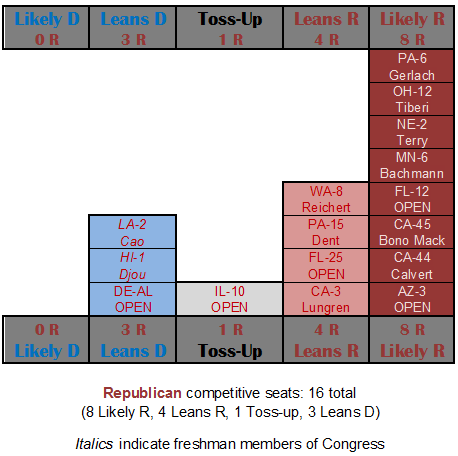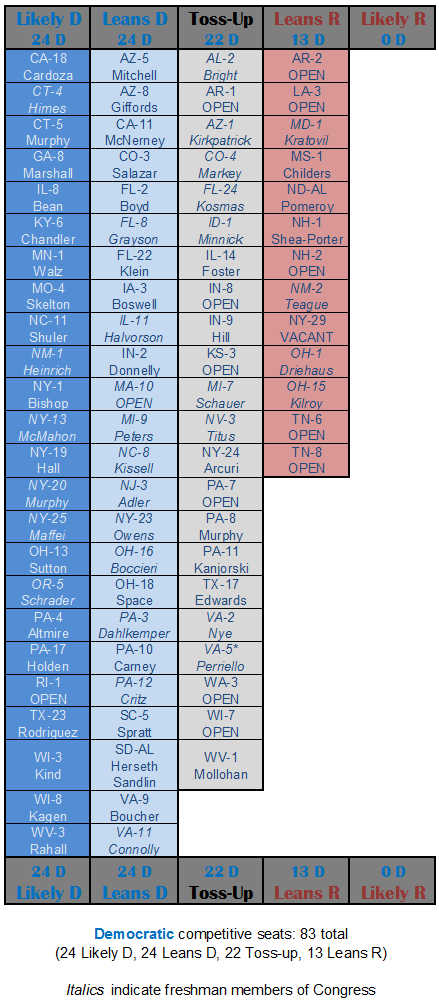May House Update
A Commentary by Isaac Wood
Like many beleaguered sports fans, as the calendar turned to 2010, Republicans across the country were conjuring up the same thought: “This is the year!” After disastrous House elections in 2006 and 2008, Republicans dropped from their high-water mark of 232 House seats—their largest total since 1949—to just 178—their lowest total in a decade and a half. This precipitous decline brought considerable frustration to the new minority party. 2010 appeared to offer the chance for historic rebirth—and in many ways it still does.
The real question of this midterm election is not whether a Republican tide is imminent, but how high it will be. From 1938 onwards, in only two of eighteen midterm elections (1998 and 2002) has the party shut out of the White House failed to gain House seats. With so many seats to defend, and dozens of them in Republican-leaning districts, Democrats have obvious, substantial disadvantages this year. However, the sizeable Democratic majority in Congress is not only a sign of opportunity for the GOP but a bulwark for Democrats. Even after winning a House special election in Hawaii’s 1st District to pick up a new seat last week, Republicans still need a net gain of 39 seats this November to retake the House majority. And the Hawaii seat is shaky indeed for the GOP.
Unlike some analysts, we have never once predicted that Republicans would win enough new House seats to take control of the chamber. They may well do so in November due to the factors with which we’re all familiar (a bad economy, sagging presidential popularity, public concern over spending and debt, and so on). But in our eyes, there has been and still is insufficient data to suggest an impending turnover.
Indeed, our instincts were validated with the results in PA-12, the special election on May 18 to fill the seat of the late Rep. John Murtha (D). Given the nature of that district, not to mention the Democratic Party’s long string of successes in special elections, we were astonished to see some analysts tilt the contest to Republican Tim Burns in the run-up to Election Day. If anything, we felt our designation of “toss-up” understated the upside potential for Democrat Mark Critz—not least because of the hot statewide Democratic contests for U.S. senator and governor and the absence of the same on the GOP side. Sure enough, the vote tally wasn’t even close, with Critz winning 52.6% to Burns’ 45.1%.
The subsequent special election in Hawaii’s 1st district, announced May 22nd, further confirmed our outlook on 2010. Yes, Republican Charles Djou grabbed the seat of resigned Rep. Neil Abercrombie (D), but by the weak margin of 39.4% to 30.8 % for Democrat Colleen Hanabusa and 27.6% for former Democratic Congressman Ed Case. Democrats will have only one candidate in November, and it will be hard for them to lose again as long as they can keep their quarrelsome party leaders together. Even with factionalism, the eventual Democratic nominee may well be favored.
With these broad themes playing out nationwide, we turn our attention to the individual races which can sometimes get lost in the generalizations. This chart shows the 16 Republican-held seats where Democrats have a reasonable chance to mount competitive challenges in November:
One particular category of contests should be a cause of concern for Republicans in their quest to retake the House. The three GOP-held seats already tilting towards Democrats would require a 42-seat net GOP pick-up instead of just 39, since every seat lost is one more that must be taken from Democratic hands. The other seats included in the chart are important as well, since Republicans must reduce the number of their own seats that become competitive. A dollar spent to save a Republican incumbent is a dollar that can’t be used to defeat a Democratic incumbent.
While Republicans have almost no chance of duplicating the 2006 Democratic feat of holding every single Democratic-held seat, the short list of potentially competitive Republican seats shows what a good year 2010 could be for the GOP.
The list of Democratic-held seats that are vulnerable this year is not nearly as compact. This chart shows all 83 seats currently held by Democrats where Republicans have some chance of winning this year:
The most obvious difference between the Republican and Democratic charts is in the number of seats each party will be defending. All told, Democrats will have to deal with over five times as many competitive House races in their districts as Republicans will. This disparity is a simple consequence of the huge Democratic gains in 2006 and 2008, with Democrats now inhabiting many districts that are tight battlegrounds or tilted towards the GOP.
At this point, the Crystal Ball believes Republicans would pick up 32 House seats if the midterm election were held today—an increase from our earlier estimate of 27. How do we arrive at the number 32? We have 13 Democratic-held seats clearly leaning to the Republican Party, with 22 more races as pure toss-ups that may well go GOP—minus the three Republican seats tilting to the Democrats. At this mid-point of the election year—recognizing that many things could change in individual contests and overall national conditions may shift as well by November, this number of net Democratic losses is a reasonable guess. Long-range regression analysis based on time-tested election data also place GOP gains in this general neighborhood or a bit higher.
If this projection holds, 2010 will produce a sizeable Republican victory that will limit to a great degree what Democrats could pass in the House of Representatives. Remaining Democratic Blue Dogs could be expected to defect with some frequency on more liberal Obama Administration-backed legislation. A 32-seat gain would also be the largest since 1994.
At the same time, Republicans would remain in the House minority. Even a small Democratic majority in the House would produce Obama victories in some areas, and Democrats would retain committee chairmanships and all the perks that come with being in charge.
Republicans would have every reason to boast about a 32-seat gain. But it may appear diminished if GOP leaders continue to project that the party will pick up 60, 70, even 100 seats or more, as some Republicans have done in the past couple of months. Barring a massive GOP wave, these predictions appear to be unrealistic daydreams. In politics, expectations matter, and more than a few prominent Republicans are setting the bar ridiculously high—at least given what we are seeing in the key districts across the nation in late May.
Isaac T. Woods is the House Race Editor for Sabato's Crystal Ball at the University of Virginia.
See Other Political Commentary
See Other Commentaries By Isaac T. Wood
Views expressed in this column are those of the author, not those of Rasmussen Reports.
Rasmussen Reports is a media company specializing in the collection, publication and distribution of public opinion information.
We conduct public opinion polls on a variety of topics to inform our audience on events in the news and other topics of interest. To ensure editorial control and independence, we pay for the polls ourselves and generate revenue through the sale of subscriptions, sponsorships, and advertising. Nightly polling on politics, business and lifestyle topics provides the content to update the Rasmussen Reports web site many times each day. If it's in the news, it's in our polls. Additionally, the data drives a daily update newsletter and various media outlets across the country.
Some information, including the Rasmussen Reports daily Presidential Tracking Poll and commentaries are available for free to the general public. Subscriptions are available for $4.95 a month or 34.95 a year that provide subscribers with exclusive access to more than 20 stories per week on upcoming elections, consumer confidence, and issues that affect us all. For those who are really into the numbers, Platinum Members can review demographic crosstabs and a full history of our data.
To learn more about our methodology, click here.





